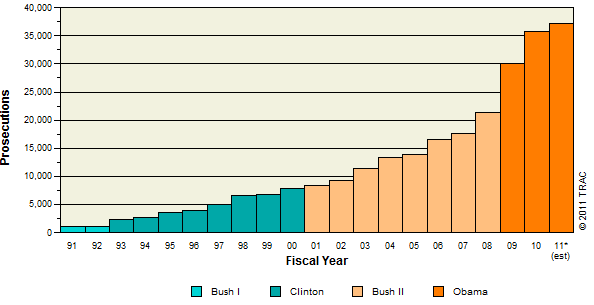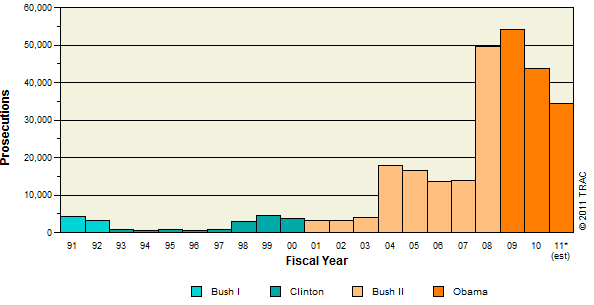Illegal reentry under Title 8, Section 1326 of the United States Code was the most commonly recorded lead charge brought by federal prosecutors during the first half of FY 2011. It alone accounted for nearly half (47 percent) of all criminal immigration prosecutions filed. It accounted for just under a quarter (23 percent) of overall criminal prosecutions, surpassing illegal entry (Title 8, Section 1325) as the most frequently cited federal lead charge.
The latest available data from the Justice Department show the government reported 18,552 new prosecutions for illegal reentry during the first six months of this fiscal year. If this activity continues at the same pace, the annual total of prosecutions will be 37,104 for this fiscal year. According to the case-by-case information analyzed by the Transactional Records Access Clearinghouse (TRAC), this estimate is up 3.5 percent over FY 2010, when the number of prosecutions totaled 35,836.
Trends over the past twenty years show how, under the Obama Administration, prosecutions for this statute continue to top those under previous administrations (see Figure 1 and supporting table).
Illegal reentry is a felony offense and results in longer sentences than the second most frequent immigration charge brought this year, illegal entry, which is classed as a petty misdemeanor. During the first six months of 2011, the average prison sentence was 14 months for those convicted where illegal reentry was recorded as the lead charge. This contrasts with an average of only 1 month prison time for convictions where the recorded lead charge was just illegal entry. Together, these two statutes account for over nine out of ten (91 percent) of all immigration criminal prosecutions.
As mentioned above, this year is also the first year that recorded prosecutions for illegal reentry surpassed those of illegal entry, which have been declining from their high during FY 2009 (see Figure 2 for the twenty year trends for this statute).

Figure 3. Border Patrol Criminal Prosecutions
Compared with Border Apprehensions
Virtually all prosecutions for illegal entry (98 percent) are the result of investigations by the Border Patrol, and the number of border apprehensions have fallen off sharply particularly beginning in FY 2007. Relative to the number of apprehensions at the border, however, the odds of being criminally prosecuted have actually been climbing (see Figure 3 and supporting Table 1).
| Fiscal Year | Apprehensions | Criminal Prosecutions — Border Patrol | |||
| Illegal Entry | Other Charge | Total | Ratio | ||
| 2006 | 1,089,092 | 12,703 | 14,215 | 26,918 | 2% |
| 2007 | 876,704 | 13,312 | 16,859 | 30,171 | 3% |
| 2008 | 723,825 | 48,434 | 19,770 | 68,204 | 9% |
| 2009 | 556,041 | 52,732 | 26,065 | 78,797 | 14% |
| 2010 | 463,382 | 42,876 | 30,866 | 73,742 | 16% |
| District | Prosecutions |
| -All- | 39,152 |
| Arizona | 12,780 |
| Texas, S | 11,226 |
| Texas, W | 6,091 |
| N Mexico | 2,349 |
| Cal, S | 2,073 |
| Cal, C | 324 |
| Utah | 263 |
| Fla, S | 246 |
| Fla, M | 176 |
| Virg, E | 170 |
Arizona still leads the way in criminal immigration prosecutions where a total of 12,780 prosecutions were filed during the first six months of FY 2011.
In second place was the Southern District of Texas (Houston) where federal prosecutors recorded 11,226 new prosecutions. The other three southwest border districts round out the top five. Table 2 shows prosecutions for the top 10 districts in the country.
Utah was the only district making the top 10 which does not have a land or sea border.
Note: This report focuses only on criminal prosecutions. It is important to keep in mind that individuals who are not criminally prosecuted may be deported administratively. Indeed, the vast majority of apprehensions are dealt with via administrative actions such as "removals" and "voluntary departures." For more information, see the earlier TRAC report Controlling the Borders.

